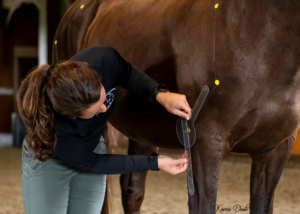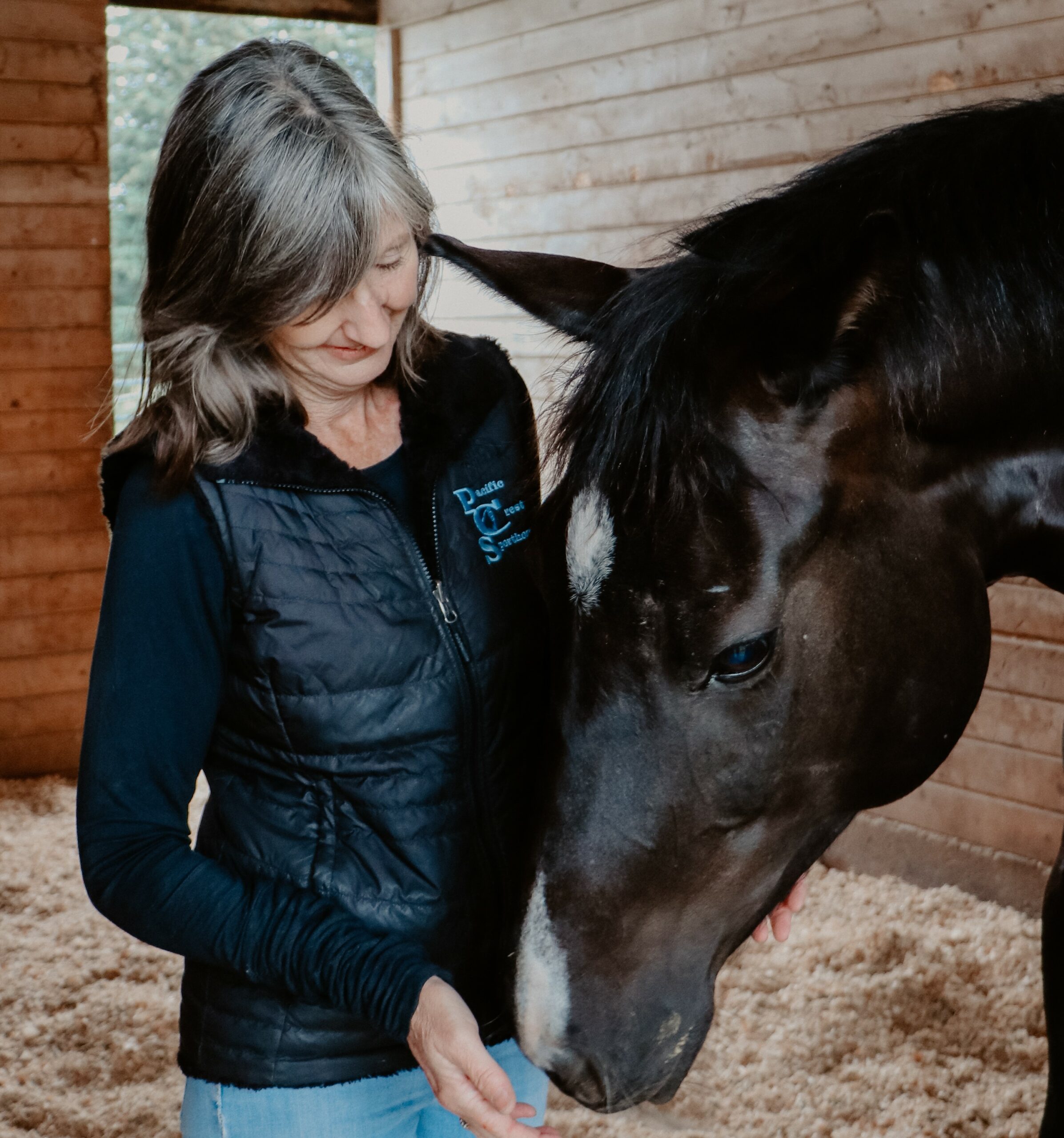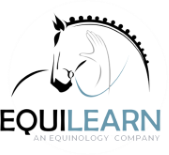
EQ300-600: Equine Biomechanics, Gait Abnormalities & Lameness
Date:
Location:
Cost:
Duration:
*This course has been approved for 32 hours of continuing education credit in jurisdictions that recognize RACE approval.
When you step back to look at a horse or when you watch a horse move, do you ever wonder what you should be watching to objectively evaluate conformation, gaits and asymmetry? Do you know the common conformation faults and possible consequences of various defects? Do find yourself contemplating how the muscles, tendons, ligaments and bone produce movement? Can you name the footfalls of the common gaits? Even if you have some insight into a few of the questions, the progressive horse person can always use more.
This course is appropriate for owners, trainers, competitors, healthcare practitioners or farriers. The information is presented in a variety of approaches using specimens, live horses, slides, diagrams and high-speed video. Students will learn proper palpation techniques in order to place markers for bone measurement, joint angle, and inclination. The high-speed video will allow students to view horses in slow motion for an easier assessment. Discussions among the participants on how conformation, gait, and lameness relate to performance, physical and behavior issues are encouraged. The participants will be guided through the protocol of equine gait assessments on actual horses and learn how to diagram the footfalls of the horse.
On the final day, participants will do a work-up on horses requesting blocks and other imaging from the attending veterinarians. No matter how you are involved in the horse industry, don’t miss this opportunity to improve your skills and build on your knowledge.
This class runs from 8:30am-5:00pm daily with 30 minutes for lunch and 2 hours of evening studies.
- Recognizing and Improving Your Eye for Gait Abnormalities
- Gait Problem Solving and Discussion
- Evaluating Posture in Response to Performance Issues
- Noticing Common Patterns in Gait Deficits
- Diagramming the Footfall of Gaits
- Causes and Symptoms of the Lame Horse
- Subjective Analysis of Conformation:
Limb Deviations, Rotations, and Determination of Symmetry - Basic Anatomy and Terminology
- Preventing Lameness
- Gait Analysis and Evaluation Guidelines
- Locating Palpation Points
- History of Biomechanics
- Biomechanical Techniques
- Measuring Horses
This course is open to anyone with a good knowledge of veterinary vocabulary, anatomy and horse handling skills. Students new to the field are welcome to participate as long as they have good horse handling skills, but it is highly recommended that they first register for the EQ50 Equine Anatomy Precourse Distance Study.
*This course is required for the Equinology® Equine Body Worker Level III Certification.
Required Text:
None
Course Materials (included in tuition):
Course Workbook, Handouts & Supplies
Externship (included in tuition):
Externship Grading and Certificate
Dr. Barb Crabbe, DVM, MA Bioethics

Dr. Crabbe is a graduate of the UC Davis School of Veterinary Medicine and completed an internship in large animal medicine and surgery at Washington State University. While at UC Davis she did graduate work in biomechanics studying patterns of locomotion in exercising horses.
Dr. Crabbe spent 30 years as a private practitioner and the owner of Pacific Crest Sporthorse, a 3-doctor general equine practice in Oregon, where she had a special interest in performance horse medicine. She is an FEI official veterinarian in Dressage and Jumping, and served on the treatment team for the 2018 World Equestrian Games.
In early 2023, Dr. Crabbe transitioned her practice to her two long-term associates in order to pursue her passion for ethics in veterinary medicine and completed a graduate degree from the Neiswanger Institute of Bioethics at the Stritch School of Medicine of Loyola University, Chicago. She currently serves on the AVMA’s Counsel on Veterinary Services and the AAEP’s Ethics and Professional Conduct committee.
Dr. Crabbe is a frequent contributor to a wide variety of publications including Horse and Rider and Dressage Today magazines. Her articles have won numerous American Horse Publications awards. Her book Comprehensive Guide to Equine Veterinary Medicine was published in 2007 by Sterling Publishing in New York. She is an avid dressage rider and USDF silver medalist and has won multiple USDF regional championships as well as Horse of the Year titles. In addition, she is a graduate with distinction from the USDF-L judges program.
She lives on a farm outside of Portland, Oregon with her husband Bob, a veterinary internal medicine specialist. They have two girls who are almost fully launched, and currently focus their attention on 3 dogs, a cat, a rescued mouse and 7 horses.
A $350 deposit is required to hold your spot in a course – the remainder of the tuition is due at least 45 days prior to the course start date (60 days for international instructors). The $350 deposit is nonrefundable and nontransferable, and is credited to the total tuition for the course. Confirmation letters, course outlines, required pre-study (if applicable), directions and lodging options will be sent when the $350 deposit has been received.
*This course has been approved for 32 hours of continuing education credit in jurisdictions that recognize RACE approval.
When you step back to look at a horse or when you watch a horse move, do you ever wonder what you should be watching to objectively evaluate conformation, gaits and asymmetry? Do you know the common conformation faults and possible consequences of various defects? Do find yourself contemplating how the muscles, tendons, ligaments and bone produce movement? Can you name the footfalls of the common gaits? Even if you have some insight into a few of the questions, the progressive horse person can always use more.
This course is appropriate for owners, trainers, competitors, healthcare practitioners or farriers. The information is presented in a variety of approaches using specimens, live horses, slides, diagrams and high-speed video. Students will learn proper palpation techniques in order to place markers for bone measurement, joint angle, and inclination. The high-speed video will allow students to view horses in slow motion for an easier assessment. Discussions among the participants on how conformation, gait, and lameness relate to performance, physical and behavior issues are encouraged. The participants will be guided through the protocol of equine gait assessments on actual horses and learn how to diagram the footfalls of the horse.
On the final day, participants will do a work-up on horses requesting blocks and other imaging from the attending veterinarians. No matter how you are involved in the horse industry, don’t miss this opportunity to improve your skills and build on your knowledge.
This class runs from 8:30am-5:00pm daily with 30 minutes for lunch and 2 hours of evening studies.
- Recognizing and Improving Your Eye for Gait Abnormalities
- Gait Problem Solving and Discussion
- Evaluating Posture in Response to Performance Issues
- Noticing Common Patterns in Gait Deficits
- Diagramming the Footfall of Gaits
- Causes and Symptoms of the Lame Horse
- Subjective Analysis of Conformation:
Limb Deviations, Rotations, and Determination of Symmetry - Basic Anatomy and Terminology
- Preventing Lameness
- Gait Analysis and Evaluation Guidelines
- Locating Palpation Points
- History of Biomechanics
- Biomechanical Techniques
- Measuring Horses
This course is open to anyone with a good knowledge of veterinary vocabulary, anatomy and horse handling skills. Students new to the field are welcome to participate as long as they have good horse handling skills, but it is highly recommended that they first register for the EQ50 Equine Anatomy Precourse Distance Study.
*This course is required for the Equinology® Equine Body Worker Level III Certification.
Required Text:
None
Course Materials (included in tuition):
Course Workbook, Handouts & Supplies
Externship (included in tuition):
Externship Grading and Certificate
Dr. Barb Crabbe, DVM, MA Bioethics

Dr. Crabbe is a graduate of the UC Davis School of Veterinary Medicine and completed an internship in large animal medicine and surgery at Washington State University. While at UC Davis she did graduate work in biomechanics studying patterns of locomotion in exercising horses.
Dr. Crabbe spent 30 years as a private practitioner and the owner of Pacific Crest Sporthorse, a 3-doctor general equine practice in Oregon, where she had a special interest in performance horse medicine. She is an FEI official veterinarian in Dressage and Jumping, and served on the treatment team for the 2018 World Equestrian Games.
In early 2023, Dr. Crabbe transitioned her practice to her two long-term associates in order to pursue her passion for ethics in veterinary medicine and completed a graduate degree from the Neiswanger Institute of Bioethics at the Stritch School of Medicine of Loyola University, Chicago. She currently serves on the AVMA’s Counsel on Veterinary Services and the AAEP’s Ethics and Professional Conduct committee.
Dr. Crabbe is a frequent contributor to a wide variety of publications including Horse and Rider and Dressage Today magazines. Her articles have won numerous American Horse Publications awards. Her book Comprehensive Guide to Equine Veterinary Medicine was published in 2007 by Sterling Publishing in New York. She is an avid dressage rider and USDF silver medalist and has won multiple USDF regional championships as well as Horse of the Year titles. In addition, she is a graduate with distinction from the USDF-L judges program.
She lives on a farm outside of Portland, Oregon with her husband Bob, a veterinary internal medicine specialist. They have two girls who are almost fully launched, and currently focus their attention on 3 dogs, a cat, a rescued mouse and 7 horses.
A $350 deposit is required to hold your spot in a course – the remainder of the tuition is due at least 45 days prior to the course start date (60 days for international instructors). The $350 deposit is nonrefundable and nontransferable, and is credited to the total tuition for the course. Confirmation letters, course outlines, required pre-study (if applicable), directions and lodging options will be sent when the $350 deposit has been received.
